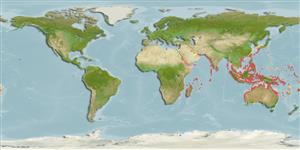Common names from other countries
>
Anguilliformes (Eels and morays) >
Muraenidae (Moray eels) > Muraeninae
Etymology: Gymnothorax: Greek, gymnos = naked + Greek, thorax, -akos = breast (Ref. 45335).
More on author: Bleeker.
Environment: milieu / climate zone / depth range / distribution range
Ecología
marino asociado a arrecife; rango de profundidad 0 - 20 m (Ref. 90102). Tropical
Indo-West Pacific: East Africa to the Marshall Islands, north to the Ryukyu Islands, south to Australia. Likely to occur in Seychelles (Ref. 1623).
Length at first maturity / Tamaño / Peso / Age
Maturity: Lm ?, range 44 - ? cm
Max length : 80.0 cm TL macho / no sexado; (Ref. 1602)
Espinas dorsales (total) : 0; Radios blandos dorsales (total) : 0; Espinas anales: 0; Radios blandos anales: 0; Vértebra: 134 - 145. Chestnut brown species that becomes darker posteriorly. Differs from the uniformly brown G. pindae by lacking the fine serrations on the posterior edges of the lower jaw teeth and by having a mouth that may not quite close completely.
Inhabits relatively turbid areas of sheltered lagoon reefs (Ref. 1602, 37816). Including mangroves in 1-20 m (Ref 90102). Minimum depth reported taken from Ref. 86942.
Life cycle and mating behavior
Maturities | Reproducción | Spawnings | Egg(s) | Fecundities | Larva
Myers, R.F., 1991. Micronesian reef fishes. Second Ed. Coral Graphics, Barrigada, Guam. 298 p. (Ref. 1602)
IUCN Red List Status (Ref. 130435)
CITES (Ref. 128078)
Not Evaluated
Threat to humans
Harmless
Human uses
Pesquerías: escaso valor comercial
Herramientas
Special reports
Download XML
Fuentes de Internet
Estimates based on models
Preferred temperature (Ref.
115969): 24.4 - 29.3, mean 28.4 (based on 3191 cells).
Phylogenetic diversity index (Ref.
82804): PD
50 = 0.5000 [Uniqueness, from 0.5 = low to 2.0 = high].
Bayesian length-weight: a=0.00047 (0.00025 - 0.00089), b=3.28 (3.13 - 3.43), in cm Total Length, based on LWR estimates for this Genus-body shape (Ref.
93245).
Nivel trófico (Ref.
69278): 4.0 ±0.6 se; based on size and trophs of closest relatives
Resiliencia (Ref.
120179): Bajo, población duplicada en un tiempo mínimo de 4.5-14 años (Preliminary K or Fecundity.).
Fishing Vulnerability (Ref.
59153): Moderate to high vulnerability (52 of 100).
